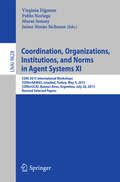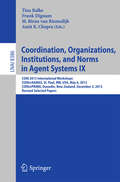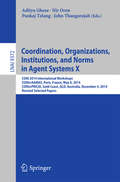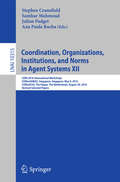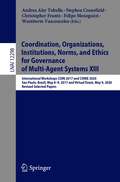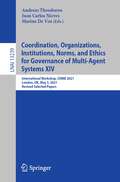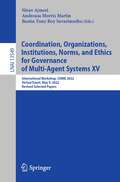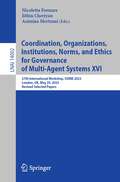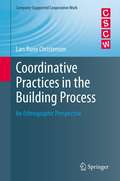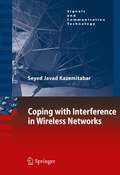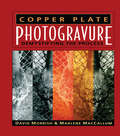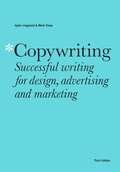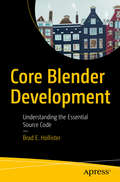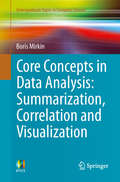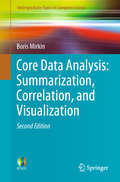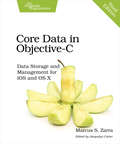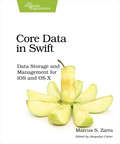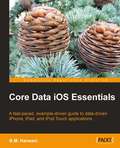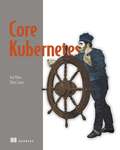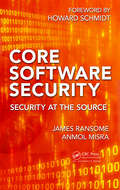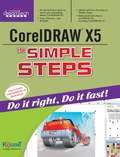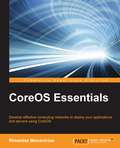- Table View
- List View
Coordination, Organizations, Institutions, and Normes in Agent Systems XI: COIN 2015 International Workshops, COIN@AAMAS, Istanbul, Turkey, May 4, 2015, COIN@IJCAI, Buenos Aires, Argentina, July 26, 2015, Revised Selected Papers (Lecture Notes in Computer Science #9628)
by Virginia Dignum Pablo Noriega Murat Sensoy Jaime Simão Simão SichmanThis book constitutes the thoroughly refereed post-conference proceedings of the 11th International Workshops on Coordination, Organizations, Institutions and Norms in Agent Systems, COIN 2015. The workshops were co-located with AAMAS 2015, held in Istanbul, Turkey, in May 2015, and with IJCAI 2015, held in Buenos Aires, Argentina, in July 2015. The 23 full papers were carefully reviewed and selected from 46 initial submissions for inclusion in this volume. The papers cover a wide range of topics from work on formal aspects of normative and team based systems, to software engineering with organizational concepts, to applications of COIN based systems, and to philosophical issues surrounding socio-technical systems. They highlight not only the richness of existing work in the field, but also point out the challenges and exciting research that remains to be done in the area.
Coordination, Organizations, Institutions, and Norms in Agent Systems IX: COIN 2013 International Workshops, COIN@AAMAS, St. Paul, MN, USA, May 6, 2013, COIN@PRIMA, Dunedin, New Zealand, December 3, 2013, Revised Selected Papers (Lecture Notes in Computer Science #8386)
by Tina Balke, Frank Dignum, M. Birna Riemsdijk and Amit K. ChopraThis book constitutes the thoroughly refereed proceedings of the 9th International Workshops on Coordination, Organizations, Institutions and Norms in Agent Systems, COIN 2013. The workshops were co-located with AAMAS 2013, held in St. Paul, MN, USA in May 2013, and with PRIMA 2013, held in Dunedin, New Zealand, in December 2013. The 18 full papers were carefully reviewed and selected from 28 submissions and are presented together with two invited papers. The papers are organized in topical sections such as coordination, organizations, institutions, norms, norm conflict, and norm-aware agents.
Coordination, Organizations, Institutions, and Norms in Agent Systems X: COIN 2014 International Workshops, COIN@AAMAS, Paris, France, May 6, 2014, COIN@PRICAI, Gold Coast, QLD, Australia, December 4, 2014, Revised Selected Papers (Lecture Notes in Computer Science #9372)
by Aditya Ghose Nir Oren Pankaj Telang John ThangarajahThis book constitutes the thoroughly refereed post-conference proceedings of the 10th International Workshops on Coordination, Organizations, Institutions and Norms in Agent Systems, COIN 2014. The workshops were co-located with AAMAS 2014, held in Paris, France, in May 2014, and with PRICAI 2014, held in Gold Coast, QLD, Australia, in December 2014. The 16 full papers were carefully reviewed and selected for inclusion in this volume. The papers cover a wide range of topics from work on formal aspects of normative and team based systems, to software engineering with organisational concepts, to applications of COIN based systems, and to philosophical issues surrounding socio-technical systems. They highlight not only the richness of existing work in the field, but also point out the challenges and exciting research that remains to be done in the area.
Coordination, Organizations, Institutions, and Norms in Agent Systems XII: COIN 2016 International Workshops, COIN@AAMAS, Singapore, Singapore, May 9, 2016, COIN@ECAI, The Hague, The Netherlands, August 30, 2016, Revised Selected Papers (Lecture Notes in Computer Science #10315)
by Julian Padget Ana Paula Rocha Stephen Cranefield Samhar MahmoudThis book constitutes the thoroughly refereed post-conference proceedings of the 12th International Workshops on Coordination, Organizations, Institutions and Norms in Agent Systems, COIN 2016. The workshop COIN@AAMAS 2016 was held in Singapore, Singapore, in May 2016, and the workshop COIN@ECAI 2016 was held in The Hague, The Netherlands, in August 2016. The 9 full papers were carefully reviewed and selected from 15 submissions for inclusion in this volume. They cover the following topics:Social Issues: The papers focus on the security of personal data, support for self-care for individuals with chronic conditions, analysis of the risk of information leakage in social networks, and an analysis of issues arising in the design of on-line environments whose participants are human and software. Teams: The papers consider different aspects of team working: what kinds of knowledge sharing best contribute to effective team performance and how to organize a tea m to function effectively in different kinds of scenarios. Rights and Values: The papers examine complementary issues that influence the effective design of normative systems, namely how to detect opportunism so that it may be discouraged, how individuals values influence (collective) decision-making processes and how rights and powers relate to value and conflict resolution in nested organizational structures.
Coordination, Organizations, Institutions, Norms, and Ethics for Governance of Multi-Agent Systems XIII: International Workshops COIN 2017 and COINE 2020, Sao Paulo, Brazil, May 8-9, 2017 and Virtual Event, May 9, 2020, Revised Selected Papers (Lecture Notes in Computer Science #12298)
by Andrea Aler Tubella Stephen Cranefield Christopher Frantz Felipe Meneguzzi Wamberto VasconcelosThis book constitutes the thoroughly refereed post-conference proceedings of the International Workshop on Coordination, Organizations, Institutions, and Norms for Governance of Multi-Agent Systems, COIN 2017, co-located with AAMAS 2017, and the International Workshop on Coordination, Organizations, Institutions, Norms and Ethics for Governance of Multi-Agent Systems, COINE 2020, co-located with AAMAS 2020. The COIN 2017 workshop was held in Sao Paulo, Brazil, in May 2017 and the COINE 2020 workshop was held virtually, in May 2020. The 9 full papers and 1 short paper were carefully reviewed and selected from a total of 20 submissions for inclusion in this volume and cover the following topics: empirical applications of COINE technologies; emergence and social metrics; and conceptual frameworks and architectures.
Coordination, Organizations, Institutions, Norms, and Ethics for Governance of Multi-Agent Systems XIV: International Workshop, COINE 2021, London, UK, May 3, 2021, Revised Selected Papers (Lecture Notes in Computer Science #13239)
by Andreas Theodorou Juan Carlos Nieves Marina De VosThis book constitutes revised selected papers from the thoroughly refereed proceedings of the International Workshop on Coordination, Organizations, Institutions, Norms, and Ethics for Governance of Multi-Agent Systems XIV, COINE 2021, held in London, UK, May 3, 2021. The 9 full papers included in this book were carefully reviewed and selected from 12 submissions. They were organized in topical sections as follows: Invited talk; conceptual frameworks architectures for collaboration and coordination; and modelling and understanding social behaviour using COINE technologies.
Coordination, Organizations, Institutions, Norms, and Ethics for Governance of Multi-Agent Systems XV: International Workshop, COINE 2022, Virtual Event, May 9, 2022, Revised Selected Papers (Lecture Notes in Computer Science #13549)
by Nirav Ajmeri Andreasa Morris Martin Bastin Tony Roy SavarimuthuThis book constitutes the thoroughly refereed post-conference proceedings of the International Workshop on Coordination, Organizations, Institutions, and Norms for Governance of Multi-Agent Systems, COINE 2022, which was held in Auckland, New Zealand, on May 9, 2022.The 14 papers included in these proceedings were carefully reviewed and selected from 15 submissions. They deal with autonomous agents and multi-agent systems, focusing on the scientific and technological aspects of social coordination, organizational theory, artificial (electronic) institutions, and normative and ethical MAS.
Coordination, Organizations, Institutions, Norms, and Ethics for Governance of Multi-Agent Systems XVI: 27th International Workshop, COINE 2023, London, UK, May 29, 2023, Revised Selected Papers (Lecture Notes in Computer Science #14002)
by Nicoletta Fornara Jithin Cheriyan Asimina MertzaniThis book constitutes the refereed proceedings of the 27th International Workshop on Coordination, Organizations, Institutions, Norms, and Ethics for Governance of Multi-Agent Systems, COINE 2023, held in London, UK, on May 29, 2023 (co-located with 22nd International Conference on Autonomous Agents and Multi-Agent Systems (AAMAS)).This book contains 10 full papers which are the extended and revised versions of the papers accepted to the workshop.The papers were carefully reviewed and selected from 13 submissions. They are organized in topical sections as follows: Norms, Social contracts, Institutions, and Privacy; Studies on the notion of Value; and Argumentation and Conventions
Coordinative Practices in the Building Process: An Ethnographic Perspective (Computer Supported Cooperative Work)
by Lars Rune ChristensenCoordinative Practices in the Building Process: An Ethnographic Perspective presents the principles of the practice-oriented research programmes in the CSCW and HCI domains, explaining and examining the ideas and motivations behind basing technology design on ethnography. The focus throughout is on generating ethnographically informed accounts of the building process and discussing the concepts of cooperative work and coordinative practices in order to frame technology development. Lars Rune Christensen provides an invaluable resource for these communities in this book. Illustrated with real examples from the building process, he reports on the cooperative work and coordinative practices found, allowing readers to feel that they know, from the point of view of the people working in the building process, what it is like to coordinate and do this kind of cooperative work.
Coping with Interference in Wireless Networks (Signals and Communication Technology)
by Seyed Javad KazemitabarUnlike wired networks where transmitters have no effect on receivers other than their own, in wireless networks we are limited by interference. The traditional routing methods are not optimal any more when it comes to a wireless medium. The maximum data rate on each link depends not only on the power in that link but also on the transmitted power from adjacent links. That is why the problem of power optimal routing needs to be solved jointly with scheduling. This suggests a cross layer design method as opposed to traditional networking where the algorithm for each layer is designed separately. In Coping with Interference in Wireless Networks we introduce several methods engaging different layers of network to mitigate interference in a wireless network.
Copper Plate Photogravure: Demystifying the Process (Alternative Process Photography Ser.)
by David Morrish Marlene MacCallumCopper Plate Photogravure describes in comprehensive detail the technique of traditional copper plate photogravure as would be practiced by visual artists using normally available facilities and materials. Attention is paid to step-by-step guidance through the many stages of the process. A detailed manual of technique, Copper Plate Photogravure also offers the history of the medium and reference to past alternative methods of practice.Copper Plate Photogravure: Demystifying the Process is part of the current revitalization of one of the most satisfyingly beautiful image-making processes. The range of ink color and paper quality possibilities is endless. The potential for handwork and alteration of the copper plate provides yet another realm of expressive variation. The subject matter and the treatment are as variable and broad as photography itself. This book's purpose is to demystify and clarify what is a complex but altogether "do-able" photomechanical process using currently available materials. With Copper Plate Photogravure, you will learn how to:· produce a full-scale film positive from a photographic negative· sensitize the gravure tissue to prepare it for exposure to the positive · prepare the plate and develop the gelatin resist prior to etching· prepare the various strengths of etching solutions and etch the plate to achieve a full tonal scale· rework the plate using printmaking tools to correct flaws or to adjust the image for aesthetic reasons· use the appropriate printing inks, ink additives, quality papers, and printshop equipment to produce a high quality printA historical survey and appendices of detailed technical information, charts, and tables are included, as well as a list of suppliers and sources for the materials required, some of which are highly specialized. A comprehensive glossary introduces the non-photographer or non-printmaker to many of the terms particular to those fields and associated with this process.
Copyright Exceptions: The Digital Impact
by Robert Burrell Allison ColemanThis book was first published in 2005. Copyright 'exceptions' or 'users' rights' have become a highly controversial aspect of copyright law. Most recently, Member States of the European Union have been forced to amend their systems of exceptions so as to comply with the Information Society Directive. Taking the newly amended UK legislation as a case study, this book examines why copyright exceptions are necessary and the forces that have shaped the present legislative regime in the UK. It seeks to further our understanding of the exceptions by combining detailed doctrinal analysis with insights gained from a range of other sources. The principal argument of the book is that the UK's current system of 'permitted acts' is much too restrictive and hence is in urgent need of reform, but that paradoxically the Information Society Directive points the way towards a much more satisfactory approach.
Copywriting Third Edition: Successful writing for design, advertising and marketing
by Gyles Lingwood Mark ShawWriting copy is often assumed to be a natural talent. However, there are simple techniques you can employ to craft strong written content with ease. This revised edition teaches the art of writing great copy for digital media, branding, advertising, direct marketing, retailing, catalogues, company magazines and internal communications, and aspects of writing for social media are integrated throughout. There are also new interviews and case studies. Using a series of exercises and up-to-date illustrated examples of award-winning campaigns and communication, *Copywriting, Third Edition takes you through step-by-step processes that can help you to write content quickly and effectively.
Copywriting Third Edition: Successful writing for design, advertising and marketing
by Gyles Lingwood Mark ShawWriting copy is often assumed to be a natural talent. However, there are simple techniques you can employ to craft strong written content with ease. This revised edition teaches the art of writing great copy for digital media, branding, advertising, direct marketing, retailing, catalogues, company magazines and internal communications, and aspects of writing for social media are integrated throughout. There are also new interviews and case studies. Using a series of exercises and up-to-date illustrated examples of award-winning campaigns and communication, *Copywriting, Third Edition takes you through step-by-step processes that can help you to write content quickly and effectively.
Core Blender Development: Understanding the Essential Source Code
by Brad E. HollisterLearn the essential source code of Blender and its unique build system. This book provides the inner workings of the Blender C-based source code, and will be indispensable for those wanting to contribute to this important open-source project.Blender is an open-source 3D modeling and rendering software package used in the production of assets for animated projects, 3D printing, games, and even scientific visualization. This book goes in depth and discusses the primary modules related to the GUI and the geometric modeling work. You'll start by learning how to reverse engineer geometric operators, and from there move on to the main features of the source code and how to apply them. When done, you'll have the necessary foundation for exploration in other modules of the Blender source code. Lack of software engineering knowledge, such as experience with large cross-platform code base, remains insurmountable for many new developers. While the Blender site includes much useful information, it is not detailed enough. Core Blender Development breaks down the barriers to entry for open-source development in 3-D modeling. What You’ll LearnFind the code for various functions and editors in BlenderTrack down bugs, and contribute new functionality to the Blender code baseExamine the .blend file and how it stores Blender stateUnderstand the Blender core code base beyond the community website documentationReview the explicit code traces and source files of descriptions of the code baseWho This Book Is ForPrimarily for novice to intermediate level developers and programmers with an interest in Blender, graphics, and visualization, who likely don’t have experience of reverse engineering a large code base.
Core Concepts in Data Analysis: Summarization, Correlation And Visualization (Undergraduate Topics in Computer Science)
by Boris MirkinCore Concepts in Data Analysis: Summarization, Correlation and Visualization provides in-depth descriptions of those data analysis approaches that either summarize data (principal component analysis and clustering, including hierarchical and network clustering) or correlate different aspects of data (decision trees, linear rules, neuron networks, and Bayes rule). Boris Mirkin takes an unconventional approach and introduces the concept of multivariate data summarization as a counterpart to conventional machine learning prediction schemes, utilizing techniques from statistics, data analysis, data mining, machine learning, computational intelligence, and information retrieval. Innovations following from his in-depth analysis of the models underlying summarization techniques are introduced, and applied to challenging issues such as the number of clusters, mixed scale data standardization, interpretation of the solutions, as well as relations between seemingly unrelated concepts: goodness-of-fit functions for classification trees and data standardization, spectral clustering and additive clustering, correlation and visualization of contingency data. The mathematical detail is encapsulated in the so-called "formulation" parts, whereas most material is delivered through "presentation" parts that explain the methods by applying them to small real-world data sets; concise "computation" parts inform of the algorithmic and coding issues. Four layers of active learning and self-study exercises are provided: worked examples, case studies, projects and questions.
Core Data Analysis: Summarization, Correlation And Visualization (Undergraduate Topics in Computer Science)
by Boris MirkinThis text examines the goals of data analysis with respect to enhancing knowledge, and identifies data summarization and correlation analysis as the core issues. Data summarization, both quantitative and categorical, is treated within the encoder-decoder paradigm bringing forward a number of mathematically supported insights into the methods and relations between them. Two Chapters describe methods for categorical summarization: partitioning, divisive clustering and separate cluster finding and another explain the methods for quantitative summarization, Principal Component Analysis and PageRank.
Core Data in Objective-C: Data Storage and Management for iOS and OS X
by Marcus S. ZarraCore Data is Apple's data storage framework: it's powerful, built-in, and can integrate with iCloud. Discover all of Core Data's powerful capabilities, learn fundamental principles including thread and memory management, and add Core Data to both your iOS and OS X projects. All examples in this edition are based on Objective-C and are up-to-date for the latest versions of OS X El Capitan and iOS 9.Core Data expert Marcus Zarra walks you through a fully developed application based around the Core Data APIs. You'll build on this application throughout the book, learning key Core Data principles such as NSPredicate, NSFetchRequest, thread management, and memory management.Start with the basics of Core Data and learn how to use it to develop your application. Then delve deep into the API details. Explore how to get Core Data integrated into your application properly, and work with this flexible API to create convenience methods to improve your application's maintainability. Reduce your migration difficulties, integrate your Core Data app with iCloud and Watch Kit, and use Core Data in a queue-based environment. By the end of the book, you'll have built a full-featured application, gained a complete understanding of Core Data, and learned how to integrate your application into the iPhone/iPad platform.This third edition updates all examples for OS X El Capitan and iOS 9, and gets you up to speed on changes in multithreading and batch processing. There's a new chapter on efficiently importing data from a network location, and a new discussion of how best to pre-load data into your application.What You Need:Mac OS X El Capitan and iOS 9 and a basic working knowledge of Objective-C
Core Data in Swift: Data Storage and Management for iOS and OS X
by Marcus S. ZarraCore Data is intricate, powerful, and necessary. Discover the powerful capabilities integrated into Core Data, and how to use Core Data in your iOS and OS X projects. All examples are current for OS X El Capitan, iOS 9, and the latest release of Core Data. All the code is written in Swift, including numerous examples of how best to integrate Core Data with Apple's newest programming language.Core Data expert Marcus Zarra walks you through a fully developed application based around the Core Data APIs. You'll build on this application throughout the book, learning key Core Data elements such as NSPredicate, NSFetchRequest, thread management, and memory management.Start with the basics of Core Data and learn how to use it to develop your application. Then delve deep into the API details. Explore how to get Core Data integrated into your application properly, and work with this flexible API to create convenience methods to improve your application's maintainability. Reduce your migration difficulties, integrate your Core Data app with iCloud and Watch Kit, and use Core Data in a queue-based environment. By the end of the book, you'll have built a full-featured application, gained a complete understanding of Core Data, and learned how to integrate your application into the iPhone/iPad platform.This book is based on Core Data in Objective-C, Third Edition. It focuses on Swift and adds an additional chapter on how to integrate Core Data with an efficient network implementation, with best practices on how to load and pre-load data into your Swift application.What You Need:Mac OS X El Capitan and iOS 9 and a basic working knowledge of Swift
Core Data iOS Essentials
by B. M. HarwaniThe book follows an unfolding example app, exploring the features and principles of Core Data as they are added to the app. The book is full of step-by-step instructions, clear explanations, and useful quick reference material.If you've already explored iOS development and maybe even dabbled with Core Data, this book will set your data-driven application development on a firm footing.
Core Kubernetes
by Jay Vyas Chris LoveTake a deep dive into Kubernetes inner components and discover what really powers a Kubernetes cluster. This in-depth guide shines a light on Kubernetes' murky internals, to help you better plan cloud native architectures and ensure the reliability of your systems.In Core Kubernetes you will learn about: Kubernetes base components Kubernetes networking Storage and the Container Storage Interface External load balancing and ingress Kubernetes security Different ways of creating a Kubernetes cluster Configuring Kubernetes to use a GPU To build and operate reliable Kubernetes-based systems, you need to understand what&’s going on below the surface. Core Kubernetes is an in-depth guide to Kubernetes&’ internal workings written by Kubernetes contributors Chris Love and Jay Vyas. It&’s packed with experience-driven insights and advanced techniques you won&’t find anywhere else. You&’ll understand the unique security concerns of container-based applications, minimize costly unused capacity, and get pro tips for maximizing performance. Diagrams, labs, and hands-on examples ensure that the complex ideas are easy to understand and practical to apply. About the technology Real-world Kubernetes deployments are messy. Even small configuration errors or design problems can bring your system to its knees. In the real world, it pays to know how each component works so you can quickly troubleshoot, reset, and get on to the next challenge. This one-of-a-kind book includes the details, hard-won advice, and pro tips to keep your Kubernetes apps up and running. About the book This book is a tour of Kubernetes under the hood, from managing iptables to setting up dynamically scaled clusters that respond to changes in load. Every page will give you new insights on setting up and managing Kubernetes and dealing with inevitable curveballs. Core Kubernetes is a comprehensive reference guide to maintaining Kubernetes deployments in production. What's inside Kubernetes base components Storage and the Container Storage Interface Kubernetes security Different ways of creating a Kubernetes cluster Details about the control plane, networking, and other core components About the reader For intermediate Kubernetes developers and administrators. About the author Jay Vyas and Chris Love are seasoned Kubernetes developers. Table of Contents 1 Why Kubernetes exists 2 Why the Pod? 3 Let&’s build a Pod 4 Using cgroups for processes in our Pods 5 CNIS and providing the Pod with a network 6 Troubleshooting large-scale network errors 7 Pod storage and the CSI 8 Storage implementation and modeling 9 Running Pods: How the kubelet works 10 DNS in Kubernetes 11 The core of the control plane 12 etcd and the control plane 13 Container and Pod security 14 Nodes and Kubernetes security 15 Installing applications
Core Memory
by John Alderman Mark Richards Dag SpicerAn unprecedented combination of computer history and striking images, Core Memory reveals modern technology's evolution through the world's most renowned computer collection, the Computer History Museum in the Silicon Valley. Vivid photos capture these historically important machinesincluding the Eniac, Crays 13, Apple I and IIwhile authoritative text profiles each, telling the stories of their innovations and peculiarities. Thirty-five machines are profiled in over 100 extraordinary color photographs, making Core Memory a surprising addition to the library of photography collectors and the ultimate geek-chic gift.
Core Software Security: Security at the Source
by James Ransome Anmol Misra"... an engaging book that will empower readers in both large and small software development and engineering organizations to build security into their products. ... Readers are armed with firm solutions for the fight against cyber threats."—Dr. Dena Haritos Tsamitis. Carnegie Mellon University"... a must read for security specialists, software developers and software engineers. ... should be part of every security professional’s library." —Dr. Larry Ponemon, Ponemon Institute"... the definitive how-to guide for software security professionals. Dr. Ransome, Anmol Misra, and Brook Schoenfield deftly outline the procedures and policies needed to integrate real security into the software development process. ...A must-have for anyone on the front lines of the Cyber War ..." —Cedric Leighton, Colonel, USAF (Ret.), Cedric Leighton Associates"Dr. Ransome, Anmol Misra, and Brook Schoenfield give you a magic formula in this book - the methodology and process to build security into the entire software development life cycle so that the software is secured at the source! "—Eric S. Yuan, Zoom Video CommunicationsThere is much publicity regarding network security, but the real cyber Achilles’ heel is insecure software. Millions of software vulnerabilities create a cyber house of cards, in which we conduct our digital lives. In response, security people build ever more elaborate cyber fortresses to protect this vulnerable software. Despite their efforts, cyber fortifications consistently fail to protect our digital treasures. Why? The security industry has failed to engage fully with the creative, innovative people who write software.Core Software Security expounds developer-centric software security, a holistic process to engage creativity for security. As long as software is developed by humans, it requires the human element to fix it. Developer-centric security is not only feasible but also cost effective and operationally relevant. The methodology builds security into software development, which lies at the heart of our cyber infrastructure. Whatever development method is employed, software must be secured at the source. Book Highlights: Supplies a practitioner's view of the SDL Considers Agile as a security enabler Covers the privacy elements in an SDL Outlines a holistic business-savvy SDL framework that includes people, process, and technology Highlights the key success factors, deliverables, and metrics for each phase of the SDL Examines cost efficiencies, optimized performance, and organizational structure of a developer-centric software security program and PSIRT Includes a chapter by noted security architect Brook Schoenfield who shares his insights and experiences in applying the book’s SDL framework View the authors' website at http://www.androidinsecurity.com/
CorelDRAW X5 In Simple Steps
by Kogent Learning Solutions IncCoreldraw X5 In Simple Steps (Hindi) Author: Kogent Learning Solutions Inc.
CoreOS Essentials
by Rimantas MoceviciusIf you are a system administrator with experience in network virtualization and want to develop computing networks for deploying applications and servers, then this is the book for you. Knowledge of Linux operating systems and Docker is expected.
